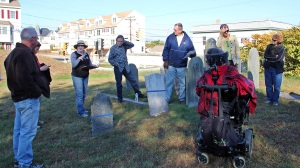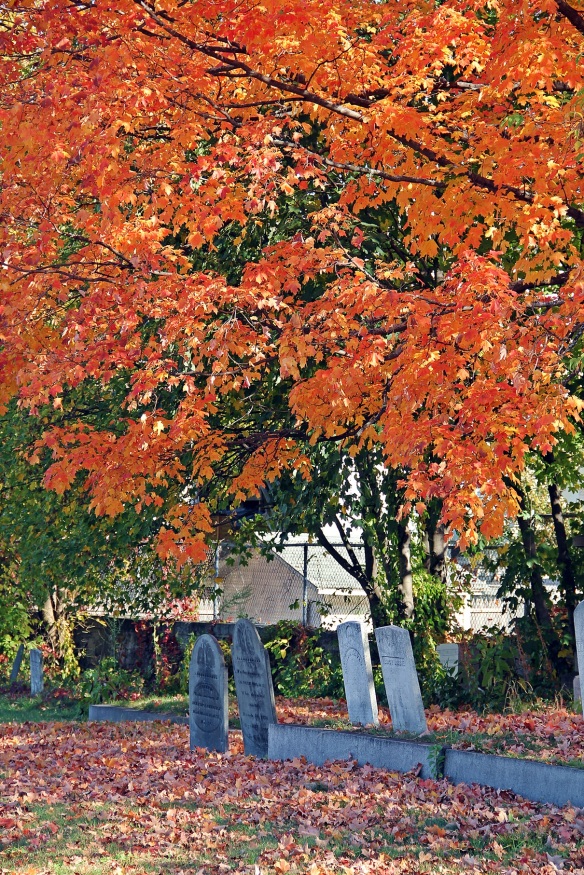By Jennifer Myers
Building and improving upon America’s first planned industrial city was dangerous work. Digging canals, working in mills and building the infrastructure that made those mills run, snatched the lives of scores of 19th century Lowellians.
His gravestone can be seen just on the other side of the fence as you stroll along School Street.
 It reads: “Died instantly at Pawtucket Dam June 15, 1875.”
It reads: “Died instantly at Pawtucket Dam June 15, 1875.”
His name was Ezra Wright. He was born February 21, 1822.
According to the 1870 census, Wright lived at 40 Butterfield St., with his wife Hannah, a homemaker, and their children, Edward, a 20-year-old machinist, and daughters Hannah, 17, and Ella, 14.
His home was worth $2,800 and his personal estate $500. His occupation was listed as “carpenter.”
His death took place the same year that construction of the final part of the Pawtucket Dam was completed. It is likely he was killed while working on the dam.
 Wright’s was one of several interesting stories both about the souls who rest there and the history and care of the monuments shared by Kim Zunino, assistant administrator of the Lowell Historic Board on an one-hour Saturday morning tour of the School Street Cemetery.
Wright’s was one of several interesting stories both about the souls who rest there and the history and care of the monuments shared by Kim Zunino, assistant administrator of the Lowell Historic Board on an one-hour Saturday morning tour of the School Street Cemetery.
 The story of the cemetery begins with Joel Spalding. In 1790, Spalding was a 48-year-old widower with two children, Jonathan and Phebe, when he purchased what is known as the Spalding House at 383 Pawtucket St., now owned and maintained by the Lowell Parks and Conservation Trust.
The story of the cemetery begins with Joel Spalding. In 1790, Spalding was a 48-year-old widower with two children, Jonathan and Phebe, when he purchased what is known as the Spalding House at 383 Pawtucket St., now owned and maintained by the Lowell Parks and Conservation Trust.
In 1810, Spalding donated land to the inhabitants of what was then East Chelmsford with the caveat that it be used as a burial ground. It became known as City Cemetery #1. The area surrounding the parcel was a large swath of farmland until after the Civil War, when the Lower Highlands neighborhood began to spring up.
 Rachel (Richardson) Parker, 45, wife of Zebulon Parker, was the first person buried in the School Street Cemetery . She died in February 1811 of consumption, what would now be called tuberculosis.
Rachel (Richardson) Parker, 45, wife of Zebulon Parker, was the first person buried in the School Street Cemetery . She died in February 1811 of consumption, what would now be called tuberculosis.
Spalding died in 1823 and is buried at School Street with his first wife, Phebe, who had died 1780 while giving birth to their daughter; his second wife, Rebecca (Carey); Jonathan Spalding, and his wife, Sarah, and their three young children John, 16 months; Jonathan Jr., 5 years; and George Otis, 11 months.
Burials continued until the mid-20th century when the Cemetery Department decided to close the School Street Cemetery.
Poor record-keeping made it impossible to determine the location of every body buried there and where open plots remained. Zunino said she has a list of about 550 people who were buried in the cemetery and can account for about half of them.
 Many of the stones in the cemetery were carved by Benjamin Day, who had a shop on Market Street (then called Lowell Street). He was a very popular stone carver from the 1830’s to the 1850’s; the stones of that time are decorated with urns and willow trees, symbols of death and mourning.
Many of the stones in the cemetery were carved by Benjamin Day, who had a shop on Market Street (then called Lowell Street). He was a very popular stone carver from the 1830’s to the 1850’s; the stones of that time are decorated with urns and willow trees, symbols of death and mourning.
Urban legend has it that the cemetery is a pet cemetery. Zunino explained that myth was perpetuated because of the “dogs” carved on some of the stones.
They actually are not dogs at all, but lambs carved on children’s stones. The cemetery includes many graves of children, whose mortality rate was high in the 19th century because of infectious diseases, such as cholera.
There are 16 men who fought in the Civil War buried in the School Street Cemetery. Zunino has found three of them, including James Eldredge Coburn, a first lieutenant of Company D of the 2nd LA Voluntary Infantry, under the command of General Benjamin Butler, of Lowell. He was “wounded in the bowels” during the siege of Port Hudson in May 1863 and died three days later.
Others buried at the School Street Cemetery include:
* The Allen family: Otis Allen owned Otis Allen and Son, a lumber company. The son, Charles Herbert Allen, was the first civil governor of Puerto Rico. His house, known as the Allen House, stands on the South Campus of UMass Lowell, serving as Chancellor Marty Meehan’s office. Though Charles Allen is buried in the LowellCemetery, his parents, Otis and Louisa, and his grandmother, Sarah, are buried at theSchool Street Cemetery , as are his sister, Sarah Jane, her first husband, Edward Hosmer, and children, Helen Louisa and Nellie.
*Capt. Benjamin Stone, although lost at sea, he was memorialized along with his family, including a 3-year-old son, who died less than a year after him, at the School Street Cemetery.
Capt. Stone was lost while aboard the schooner Roseway traveling between Newburyport and St. Martins in December 1825. He was 28 years old.
His epitaph reads:
There lies the husband in the deep
and here lies the only child
Yet cease to weep mourners its
Heavens decree
Then kiss the rod and hear the wise decree
I am thy God







